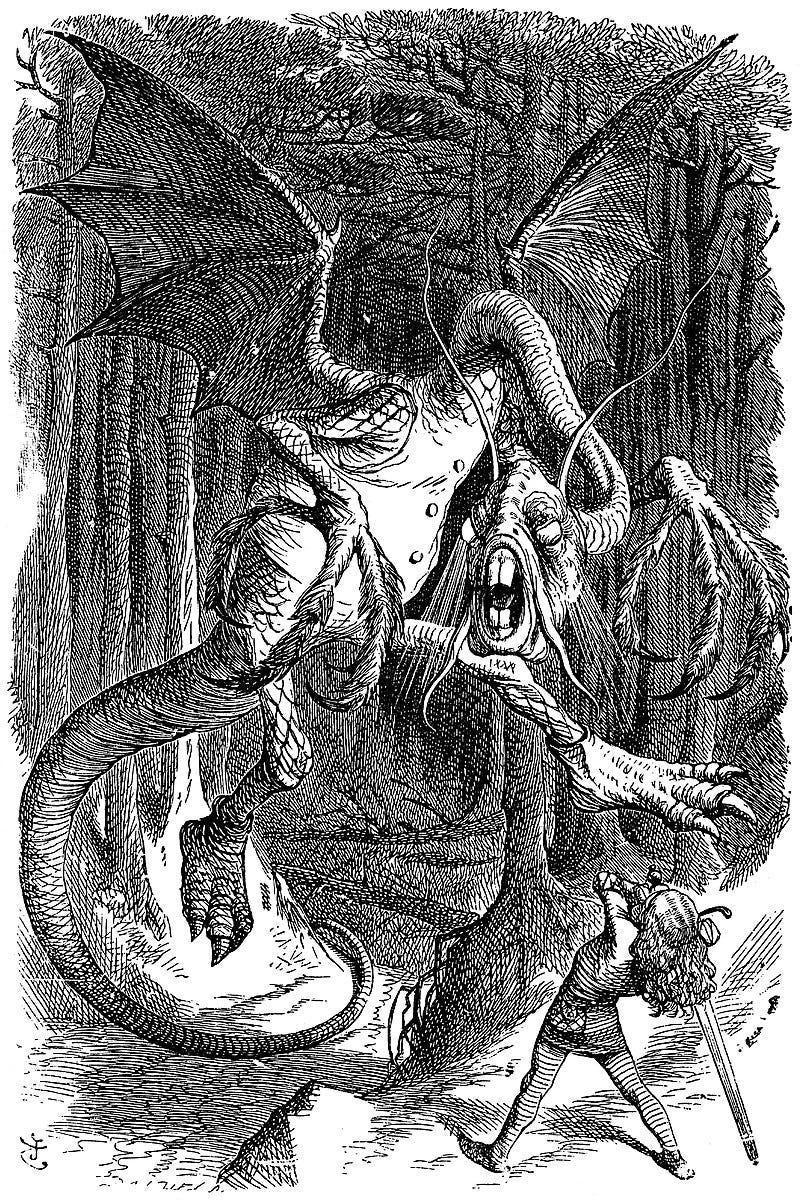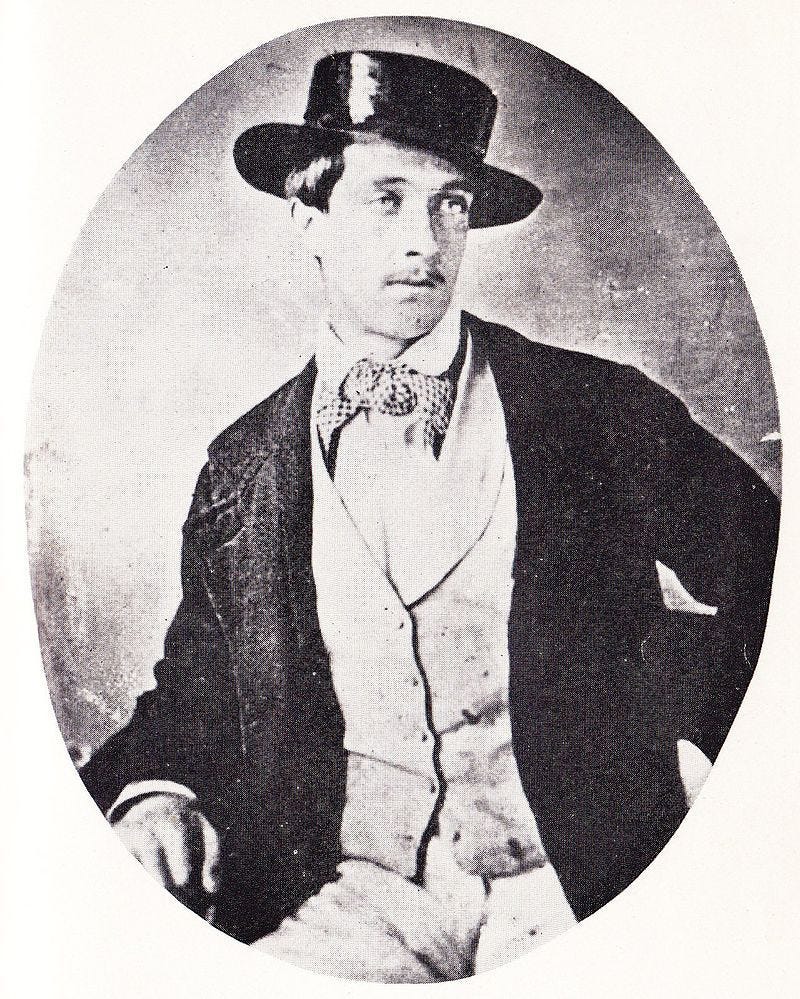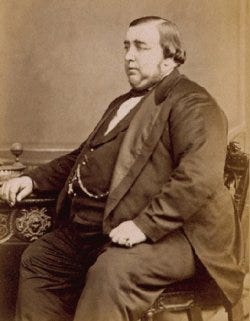This Tenniel cartoon is from Punch, March 16th 1872, and it deserves to be better known (perhaps Carroll scholars are aware of it, but it was new to me). John Tenniel was, of course, the resident artist and political cartoonist at Punch from the 1850s right through the century: it is what he was most known for in the Victorian period, although the illustrations he made for Carroll’s two Alice books were also popular. Indeed, this particular cartoon links the two magisteria: Through the Looking-Glass, and What Alice Found There had only been out for three months (it was published in December 1871), but had been enough of a success to enable Punch to run with a Carroll parody. So after his peerless illustration of Carroll’s monstrous ‘Jabberwock’ …
… he revisited the subject for a bit of topical humour. You can see that the ‘Wagga-wock’ retains the body, tail and black-wings of the original Jabberwock (the wings now labelled ‘Bonds’ and ‘Perjury’), and is still wearing the slightly incongruous waistcoat of the original beast; but his neck has been shortened, his grotesque head revised and his snail-like horns eliminated. His huge feathered claws have become human hands. Punch, the embodiment of the magazine, looks on delightedly as a legal individual (he is Sir William Bovill, Chief Justice of the Common Pleas at the time) plunges a sword labelled ‘Truth and Justice’ into the body of the prone monster.
This point of all this is the Tichborne claimant. I discuss the case at length in this old post (I begin that post by suggesting the case would be a good subject for an historical novel, not at that time realising that Zadie Smith was writing precisely that novel). Sensitive, slender, aristocratic Roger Tichborne, heir to the Tichborne baronetcy, sailed to South America and, in all likelihood, drowned when the ship he was on sunk. Here he is, in 1854, shortly before his death:
His elderly mother, in part encouraged by a clairvoyant, refused to believe that her son was dead, and put out advertisements in the Times and other papers, describing her boy as ‘of a delicate constitution, rather tall, with very light brown hair and blue eyes’ and promising ‘a most liberal reward for any information that may definitely point out his fate.’ She signed these notices ‘H. F. Tichborne.’
What happened next is that a butcher in Wagga-Wagga, New South Wales (hence Tenniel’s ‘Wagga-wock’)—Arthur Orton by name—answered the advertisement, claiming to be the lost Tichborne heir.
Lady Tichborne paid for Orton’s passage to Europe, requesting that he write a will before he left Australia in case of mishap. In this will, Orton bequeathed a non-existent Tichborne property in the Isle of Wight, and called his mother ‘Hannah Frances Tichborne’ — since he’d only ever seen her initials, and didn’t realise she was actually Henriette Felicité. He also tried, unsuccessfully, to withdraw £10,000 from a Melbourne bank, against an account held at a London house at which no Tichborne had ever banked.
So, yes, Orton was a fraud. Where the actual Roger Tichborne was extraordinarily slender, fluent in French, classically educated, sensitive and refined, Orton was very fat — when he arrived in England he weighed 15 stone, and within a few years had ballooned to 35 stone — couldn’t speak French, and couldn’t even identify which of the texts he was shown was Greek and which Latin, let alone read either. His accounts of his early life were vague and noncommittal, and mixed occasional accuracies (he was able to describe his favourite fishing tackle from when he was a boy, for instance) with large and patent errors and inventions.
Nonetheless when he arrived in Paris in 1866, and was met by Lady Tichborne, she tearfully embraced him and declared to the world that her son had returned to her. She settled an income of £1000 a year on him and made a legal deposition confirming him as heir.
The rest of the family weren’t having this. So far as they were concerned, the legal heir was Henriette’s grandson by Alfred, her second son, a baby at this time. To quote myself again:
What’s really remarkable about this story is not that Lady Tichborne believed Orton to be her lost son, but that so many other people did too. The case finally came to court in 1871: Orton, or ‘Roger’, sued to eject a certain Colonel Lushington, the tenant of Tichborne Park, and so claim the estate for himself. A successful suit would have effectively confirmed Orton’s legal identity as Roger Tichborne … There were many witnesses, including the family doctor, prepared to swear that Orton was Tichborne. Several soldiers who had served with Roger Tichborne in the Dragoons recognised Orton as him, including his former batman Thomas Carter. High society support included Lord Rivers, and the MP for Guildford, the aptly named Guildford Onslow.
How could they believe it? That’s the really fascinating thing, I think.
Anyway: things soon began to unravel for Orton. Lady Tichborne died on 12 March 1868, removing his main advocate and ending his annual stipend. He initiated a number of schemes to keep-up his income, borrowing against his claim and also selling bonds to supporters — he had a large (as we would nowadays say) ‘fanbase’, and they snapped up the issue of 1000 ‘Tichborne Bonds’, each of which could be redeemed at their face value of £100 when he entered into his inheritance. This enterprising stock-market exercise raised the staggering sum of £40,000, although, as his star began to wane, the bonds were soon being traded for tiny amounts.
That explains the ‘Bonds’ label on the fallen Wagga-wock’s right-wing.
The court case did not go well for Orton. The defence team — led by John Coleridge, one of the most distinguished lawyers of the age, and great-nephew of the poet Samuel Taylor Coleridge — was able to submit Orton’s marriage certificate from Wagga Wagga (he had married a housemaid there one Mary Ann Bryant) which showed his date of birth as 1833, not Roger’s 1829. They also showed that such details of Roger Tichborne’s childhood as Orton was correctly identifying had been fed to him by a family servant called Bogle. One witness, Lord Bellew (who had known Tichborne at Stonyhurst) testified that Roger possessed several distinctive tattoos. The Claimant, examined, was shown not to possess these. By March 1872 the jury had heard enough. Some 200 witnesses had been lined-up by the defence to prove Orton’s fraud, but they were never called: the jury instructed the judge they were ready to reject the Claimant’s suit. Orton was charged with perjury and committed to Newgate Prison. After a second, criminal trial Orton was convicted and sent down for fourteen years.
This is the occasion for the Punch cartoon: the magazine was never in any doubt that Orton was a fraud, and that is what Tenniel portrays in this cartoon. The case, though, did not die down: a significant chunk of the population continued to believe Orton was Tichborne — or perhaps knew he wasn’t but revelled in the idea of a working-class chancer making good and sticking it to the upper classes. The second, criminal trial lasted an extraordinary 188 days of court-time, with Orton being defended by a fiery but eccentric Irish lawyer called Edward Kenealy, whose ferocious manner in court led to him being dismissed by the judge and eventually being disbarred. As for Orton, ‘the Claimant’: after his release from prison he confessed to The People newspaper (for a fee of £200) that he was, after all, Arthur Orton, originally of Wapping, who had gone to sea as a boy and ended up in Australia (although he later retracted this confession). He married a music hall singer and opened a small tobacconist’s shop in Islington. But the shop failed, and he died destitute in 1898.
The Punch cartoon comes with some text: ‘Mr Punch makes his best acknowledgements to LEWIS CARROLL, author of the delightfullest fairy lore extant, for the idea of a Mysterious Monster. Everyone worth thinking about had read the sequel to Alice in Wonderland, the new book called Through the Looking-Glass. Everyone can recite the marvellous poem therein, entitled “Jabberwocky”.’ Punch then reproduces Carroll’s poem, afterwards suggesting facetiously that ‘wabe’ (‘explained by the poet to mean “a grassplot round a sun-dial”) can also mean ‘a court of justice, being derived from the Saxon waube, a wig-shop’, and adding their own parodic version of the poem:
’Twas Maytime and the lawyer coves Did gibe and jabber in the wabe, All menaced were the Tichborne groves. And their true lord, the Babe. “Beware the Waggawock my son, The eyelid twitch, the knees incline, Beware the Baigent network spun For gallant Ballantine.” He took his ton-weight brief in hand, Long time the hidden clue he sought, Then rested he by the Hawkins tree And sat a while in thought. And as in toughish thought he rocks, The Waggawock sans ruth or shame Came lumbering to the witness box, And perjured out his Claim. “Untrue! untrue!” Then, through and through The weary weeks he worked the rack: But March had youth, ere with the Truth He dealt the final whack. “And hast thou slain the Waggawock? Come to my arms my Beamish boy! O Coleridge J.! Hoorah hooray!” Punch chortled in his joy.
There are many parodies of ‘Jabberwocky’, and this is not the best of them. For the (highly recommended) Alice Through the Looking-Glass A Companion, edited by Franziska E. Kohlt (2024), I contributed a chapter that itself included four Jabberwocky parodies of my own (here is one of them). I do not suggest that these are any better than Punch’s, although in their various ways they are perhaps more pointed: the purpose of my chapter is to explore the way parody can function as literary criticism. But Tenniel’s illustration is something rarer, a self-parody, auto-gloss. Tenniel visually created the Jabberwock, and here recreates his own monster. The original illustration is of a moment of peril and excitement, as the beast comes whiffling through the tulgy wood and the boy readies himself to fight it. The second image ought to be triumphant, recording the frabjous, Callooh!-Callay! of the monster’s death. Yet Tenniel has instead created an image of pronounced pathos: the Wagga-wock himself is clearly not dead—that gentle prod with the truth-justice sword in the kidneys hardly looks fatal—but he does look as if he is weeping, covering his face with his hand, curled up in a foetal position (the tenderness of the way Tenniel has drawn his left foot tucked in behind his right!) Two smirking schoolchildren beating up the fat kid.







